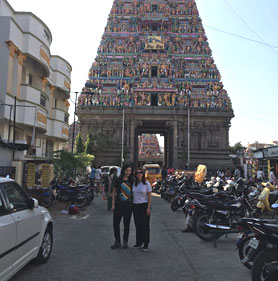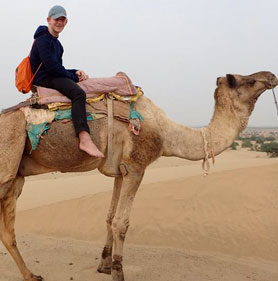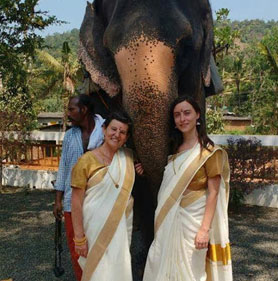Indian subcontinent boasts of housing approximately 10 percent of the total snake species found in the world, adding up to somewhere around 200 species in number. From warm seas to semi-deserts, swamps, lakes and even the Himalayan glaciers, one can find snakes in almost all the habitats in India. The snakes of India range from Worm Snakes, about 10 cm in length, to the King Cobra, measuring upto 6 m. In the following lines, we have mentioned the four most popular species of Indian snakes:
|
Cobra
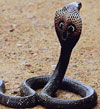 Cobra, scientifically known as Naja naja, is one of the poisonous snake species native to the Indian subcontinent. It grows to an average height of 1 m and has two circular ocelli patterns on the rear of its hood. These patterns seem to be connected by a curved line, giving the look of spectacles. This is why the snake is also known as the Spectacled Cobra of India. A newborn cobra measures between 20 to 30 cm, but has fully functional venom glands. Cobra, scientifically known as Naja naja, is one of the poisonous snake species native to the Indian subcontinent. It grows to an average height of 1 m and has two circular ocelli patterns on the rear of its hood. These patterns seem to be connected by a curved line, giving the look of spectacles. This is why the snake is also known as the Spectacled Cobra of India. A newborn cobra measures between 20 to 30 cm, but has fully functional venom glands.
|
|
King Cobra
 Indian King cobra snake belongs to the Ophiophagus Genus and is scientifically known as Ophiophagus Hannah. It is believed to be the largest poisonous terrestrial snake, measuring upto 5.7 m in length. However, the weight of a King cobra rarely exceeds 44 lb (20 kg). The venom of a king cobra is capable of killing a human being, with the mortality rate being as high as 75%. Even though the name suggest otherwise, King cobra is not of the same Genus as the other cobras. Indian King cobra snake belongs to the Ophiophagus Genus and is scientifically known as Ophiophagus Hannah. It is believed to be the largest poisonous terrestrial snake, measuring upto 5.7 m in length. However, the weight of a King cobra rarely exceeds 44 lb (20 kg). The venom of a king cobra is capable of killing a human being, with the mortality rate being as high as 75%. Even though the name suggest otherwise, King cobra is not of the same Genus as the other cobras.
|
|
Python
 Python snake, also known as Ajgar, is one of the most massively built snakes of the Indian subcontinent. It belongs to the Boidae Family and is dependent on water to quite an extent. One of the unique features of the Rock pythons of India is that they can raise their body temperature above the ambient level, through muscular contractions. Python snake, also known as Ajgar, is one of the most massively built snakes of the Indian subcontinent. It belongs to the Boidae Family and is dependent on water to quite an extent. One of the unique features of the Rock pythons of India is that they can raise their body temperature above the ambient level, through muscular contractions.
|
|
Russells Viper
 Indian Russell's Viper is known by a number of other names, like Daboia, Tic Polonga, etc. A highly poisonous snake of the Viperidae family, it is scientifically known as Vipera russelli. Russell's viper is responsible for most of the snakebite deaths within its habitat. It is light brown in color and is covered with three rows of dark brown or black splotches, bordered with white or yellow. Indian Russell's Viper is known by a number of other names, like Daboia, Tic Polonga, etc. A highly poisonous snake of the Viperidae family, it is scientifically known as Vipera russelli. Russell's viper is responsible for most of the snakebite deaths within its habitat. It is light brown in color and is covered with three rows of dark brown or black splotches, bordered with white or yellow.
|
|
Saw Scaled Viper
 Common names: Indian saw-scaled viper, little Indian viper. Also known as Echis carinatus. A small but extremely dangerous viper. It gets the name saw-scaled from rubbing the sides of its body together, producing a rasping sound. This ill-tempered snake will attack any intruder. Its venom is highly hemotoxic and quite potent. Many deaths are attributed to this species. Common names: Indian saw-scaled viper, little Indian viper. Also known as Echis carinatus. A small but extremely dangerous viper. It gets the name saw-scaled from rubbing the sides of its body together, producing a rasping sound. This ill-tempered snake will attack any intruder. Its venom is highly hemotoxic and quite potent. Many deaths are attributed to this species.
Found in a variety of environments. It is common in rural settlements, cultivated fields, arid regions, barns, and rock walls.
|
|
Purple Pit Viper
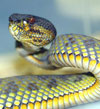 Trimeresurus purpureomaculatus is a venomous pitviper species found in parts of India and Southeast Asia. Two subspecies are currently recognized, including the nominate subspecies described here. Trimeresurus purpureomaculatus is a venomous pitviper species found in parts of India and Southeast Asia. Two subspecies are currently recognized, including the nominate subspecies described here.
Males grow to a total length of 66.5 cm, females 90 cm. The tail lengths are then 12.5 cm and 14 cm respectively.
Scales in 25-27 longitudinal rows at midbody; 11-13 upper labials, the first partially or completely united with the nasal; supraocular very narrow, sometimes broken into small scales, 12-15 scales between them; head scales small, sub equal, tuberculate or granular; temporal scales keeled; body color highly variable, above olive, grayish, to dark purplish brown, below whitish, greenish or brown, uniform or spotted with brown.
|
|
Krait
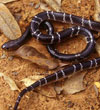 Any of 12 species of highly venomous snakes belonging to the cobra family (Elapidae). Kraits live in Asian forests and farmland from Pakistan to southern China and southward into Indonesia. They are terrestrial, feeding mainly on other snakes but also on frogs, lizards, and small mammals. Kraits are nocturnal hunters and are dangerous to humans only when stepped on or otherwise strongly provoked. Any of 12 species of highly venomous snakes belonging to the cobra family (Elapidae). Kraits live in Asian forests and farmland from Pakistan to southern China and southward into Indonesia. They are terrestrial, feeding mainly on other snakes but also on frogs, lizards, and small mammals. Kraits are nocturnal hunters and are dangerous to humans only when stepped on or otherwise strongly provoked.
The banded krait (Bungarus fasciatus) of Southeast Asia grows to 2 metres (6.6 feet), and other species commonly reach more than a metre in length. All have bodies that are strongly triangular in cross-section. Some are boldly coloured in bands of black and white or yellow; others are dark-bodied with a brightly coloured (often red) head and tail. Kraits lay eggs in clutches of 2–14, depending on the species.
|
|
Common Rat Snake
 Rat snakes are large, fast moving snakes which grow to a length of 2 ½ metres or more. Their size and color are similar to the cobras. Rat snakes are found wherever rats and frogs/toads are prevalent. So, of course, they are often found in rice fields and in human habitation. Rat snakes are large, fast moving snakes which grow to a length of 2 ½ metres or more. Their size and color are similar to the cobras. Rat snakes are found wherever rats and frogs/toads are prevalent. So, of course, they are often found in rice fields and in human habitation.
The rat snake is active during the day, hunting for rodents, frogs,toads and birds along fields and in bushes. Large rat snakes can give a painful bite and are quick to defend themselves. We have heard them growl throatily,when first caught. The color varies from jet black in the hilss all the way to yellowish or brown.
|
 Cobra, scientifically known as Naja naja, is one of the poisonous snake species native to the Indian subcontinent. It grows to an average height of 1 m and has two circular ocelli patterns on the rear of its hood. These patterns seem to be connected by a curved line, giving the look of spectacles. This is why the snake is also known as the Spectacled Cobra of India. A newborn cobra measures between 20 to 30 cm, but has fully functional venom glands.
Cobra, scientifically known as Naja naja, is one of the poisonous snake species native to the Indian subcontinent. It grows to an average height of 1 m and has two circular ocelli patterns on the rear of its hood. These patterns seem to be connected by a curved line, giving the look of spectacles. This is why the snake is also known as the Spectacled Cobra of India. A newborn cobra measures between 20 to 30 cm, but has fully functional venom glands. Indian King cobra snake belongs to the Ophiophagus Genus and is scientifically known as Ophiophagus Hannah. It is believed to be the largest poisonous terrestrial snake, measuring upto 5.7 m in length. However, the weight of a King cobra rarely exceeds 44 lb (20 kg). The venom of a king cobra is capable of killing a human being, with the mortality rate being as high as 75%. Even though the name suggest otherwise, King cobra is not of the same Genus as the other cobras.
Indian King cobra snake belongs to the Ophiophagus Genus and is scientifically known as Ophiophagus Hannah. It is believed to be the largest poisonous terrestrial snake, measuring upto 5.7 m in length. However, the weight of a King cobra rarely exceeds 44 lb (20 kg). The venom of a king cobra is capable of killing a human being, with the mortality rate being as high as 75%. Even though the name suggest otherwise, King cobra is not of the same Genus as the other cobras. Python snake, also known as Ajgar, is one of the most massively built snakes of the Indian subcontinent. It belongs to the Boidae Family and is dependent on water to quite an extent. One of the unique features of the Rock pythons of India is that they can raise their body temperature above the ambient level, through muscular contractions.
Python snake, also known as Ajgar, is one of the most massively built snakes of the Indian subcontinent. It belongs to the Boidae Family and is dependent on water to quite an extent. One of the unique features of the Rock pythons of India is that they can raise their body temperature above the ambient level, through muscular contractions. Indian Russell's Viper is known by a number of other names, like Daboia, Tic Polonga, etc. A highly poisonous snake of the Viperidae family, it is scientifically known as Vipera russelli. Russell's viper is responsible for most of the snakebite deaths within its habitat. It is light brown in color and is covered with three rows of dark brown or black splotches, bordered with white or yellow.
Indian Russell's Viper is known by a number of other names, like Daboia, Tic Polonga, etc. A highly poisonous snake of the Viperidae family, it is scientifically known as Vipera russelli. Russell's viper is responsible for most of the snakebite deaths within its habitat. It is light brown in color and is covered with three rows of dark brown or black splotches, bordered with white or yellow. Common names: Indian saw-scaled viper, little Indian viper. Also known as Echis carinatus. A small but extremely dangerous viper. It gets the name saw-scaled from rubbing the sides of its body together, producing a rasping sound. This ill-tempered snake will attack any intruder. Its venom is highly hemotoxic and quite potent. Many deaths are attributed to this species.
Common names: Indian saw-scaled viper, little Indian viper. Also known as Echis carinatus. A small but extremely dangerous viper. It gets the name saw-scaled from rubbing the sides of its body together, producing a rasping sound. This ill-tempered snake will attack any intruder. Its venom is highly hemotoxic and quite potent. Many deaths are attributed to this species. Trimeresurus purpureomaculatus is a venomous pitviper species found in parts of India and Southeast Asia. Two subspecies are currently recognized, including the nominate subspecies described here.
Trimeresurus purpureomaculatus is a venomous pitviper species found in parts of India and Southeast Asia. Two subspecies are currently recognized, including the nominate subspecies described here. Any of 12 species of highly venomous snakes belonging to the cobra family (Elapidae). Kraits live in Asian forests and farmland from Pakistan to southern China and southward into Indonesia. They are terrestrial, feeding mainly on other snakes but also on frogs, lizards, and small mammals. Kraits are nocturnal hunters and are dangerous to humans only when stepped on or otherwise strongly provoked.
Any of 12 species of highly venomous snakes belonging to the cobra family (Elapidae). Kraits live in Asian forests and farmland from Pakistan to southern China and southward into Indonesia. They are terrestrial, feeding mainly on other snakes but also on frogs, lizards, and small mammals. Kraits are nocturnal hunters and are dangerous to humans only when stepped on or otherwise strongly provoked. Rat snakes are large, fast moving snakes which grow to a length of 2 ½ metres or more. Their size and color are similar to the cobras. Rat snakes are found wherever rats and frogs/toads are prevalent. So, of course, they are often found in rice fields and in human habitation.
Rat snakes are large, fast moving snakes which grow to a length of 2 ½ metres or more. Their size and color are similar to the cobras. Rat snakes are found wherever rats and frogs/toads are prevalent. So, of course, they are often found in rice fields and in human habitation.
